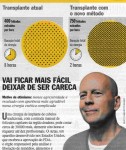Q: A while ago I saw you and you recommended FUT hair transplantation, but my friend came in and you recommended FUE. How come? — C.T., Hackensack, N.J.
A: I think that both procedures are excellent, which is why I do them both. My recommendations are determined by the individual patient. His or her age, desire to wear hair cut very short, athletic activities, donor density and miniaturization, extent of hair loss, and potential future balding are all important aspects in the decision process.



 Download
Download Bernstein Medical – Center for Hair Restoration has received a three-year re-certification for accreditation by the Accreditation Association for Ambulatory Health Care (AAAHC/Accreditation Association).
Bernstein Medical – Center for Hair Restoration has received a three-year re-certification for accreditation by the Accreditation Association for Ambulatory Health Care (AAAHC/Accreditation Association). Bernstein Medical – Center for Hair Restoration has been named as one of the best companies to work for in New York. Bernstein Medical will be honored at a public awards dinner to be held the Albany Marriott on Tuesday, April 30, 2013.
Bernstein Medical – Center for Hair Restoration has been named as one of the best companies to work for in New York. Bernstein Medical will be honored at a public awards dinner to be held the Albany Marriott on Tuesday, April 30, 2013. The 12th edition of Castle Connolly’s America’s Top Doctors includes Dr. Bernstein for his work in
The 12th edition of Castle Connolly’s America’s Top Doctors includes Dr. Bernstein for his work in 



